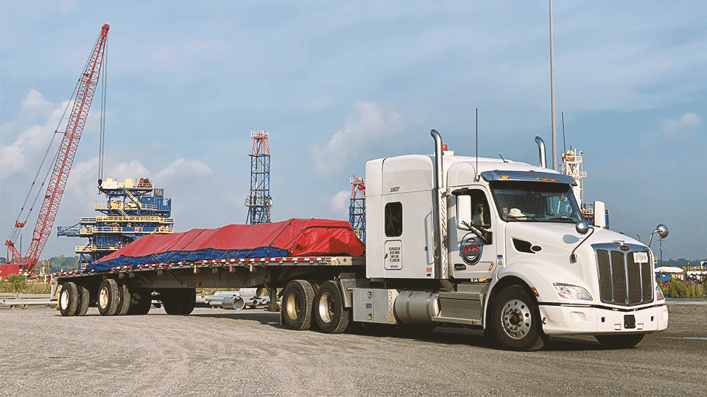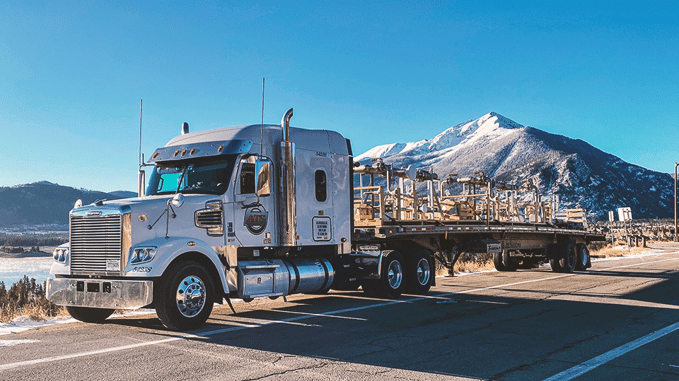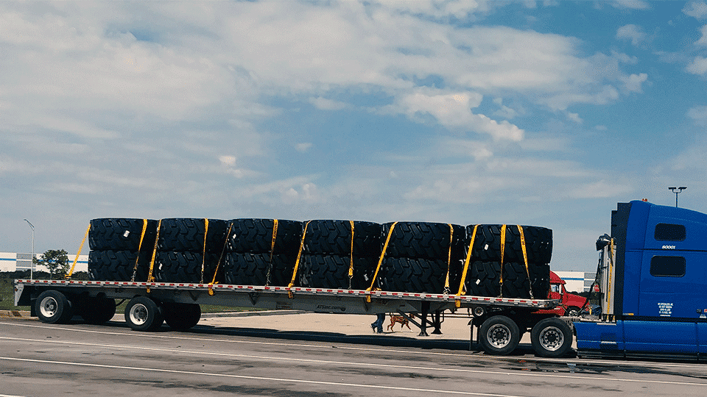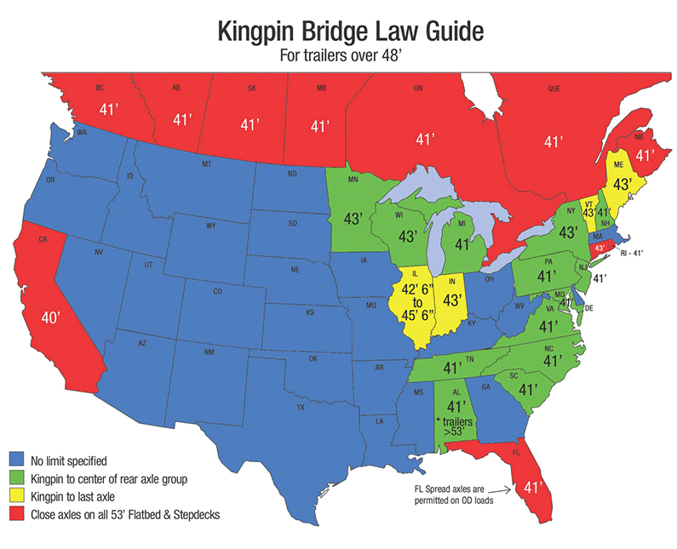- The maximum loaded weight a flatbed can haul
- The maximum loaded weight a closed-tandem flatbed can haul
- When to use closed-tandem flatbeds
- The maximum loaded weight a spread-axle flatbed can haul
- When to use spread-axle flatbeds
Planning is key to successfully moving your freight. The trucking industry is governed by a vast number of rules and regulations. Since they are levied to keep roadways, cargo and the motoring public safe, each guideline must be followed to a “t” — and then some.
However, with so many regulations to follow and so much variation in them — between states, counties and municipalities — it can be difficult for people in your position to keep everything straight.
The maximum weight you’re legally allowed to load onto a flatbed trailer is one example of this.
How much weight can a flatbed trailer legally carry?
Does this total change based on your location or axle spacings?
Arranging your next open-deck load correctly will mean answering questions like these. Here at Anderson Trucking Service (ATS), we’re familiar with legal weight limitations, how they vary and what they mean for flatbed shipments — we’ve been moving flatbed loads for nearly seven decades.
In this article, you’ll find an in-depth overview of legal flatbed weights to help you make your next shipment a success.
What Is the Maximum Loaded Weight a Flatbed Can Haul?
The maximum gross vehicle weight for all commercial motor vehicles is 80,000 pounds. This total includes the combined weight of the semi-truck, the trailer and the load in question. Flatbed trailers, which are most commonly a five-axle combination, can legally haul a maximum load weight of 46,000-48,000 pounds.
Since neither a spread axle nor a closed tandem flatbed can hoist this weight alone, these 46,000-48,000 pounds must be distributed along the length of the trailer.
Broken down further, this 80,000-pounds of gross vehicle weight must be distributed across a flatbed tractor/trailer’s five total axles (1 steer, 2 drive, 2 trailer) accordingly:
Steer axle (located at the front of the tractor): 12,000 pounds
Drive axles (located at the rear of the tractor, attached to the trailer via the fifth wheel): 34,000 pounds total — 17,000 each.
Trailer axles: 34,000 pounds.
To be safe, these are the thresholds you should strive to stick to. And, unless otherwise instructed, expect to get no more than 48,000 (distributed) pounds onto most tandem-axle flatbed trailers.
However, the total amount of loaded weight your flatbed’s axles can haul will change based on their configuration and the state(s) you're traveling through.

Once your load’s weight exceeds 46,000 pounds, the number of drivers willing to haul it dwindles. Heavier loads are hard on the equipment transporting them and with so many other loads to choose from, many drivers prefer to steer clear of these shipments.
Related Content: What are the Legal Axle Weight Limits for Commercial Vehicles?
What Is a Closed-Tandem Flatbed?
A closed-tandem flatbed is a flatbed trailer with a set of axles grouped between 40 and 96 inches apart. These are the most common types of flatbed trailers and are used to haul most open-deck cargoes, provided the commodity in question can be evenly distributed.

How Much Weight Can a Closed-Tandem Flatbed Carry?
Federal regulations limit the amount of weight a closed tandem flatbed (or any tandem grouping, for that matter) can carry to 34,000 pounds.
When Can You Use Closed-Tandem Flatbeds?
Closed-tandem flatbed trailers can be used in all regions of the U.S. and Canada without exception. For this reason, utilizing these trailers is a safe bet for all legal flatbed shipments.
As long as your commodity can be distributed along the 48-53 feet of your flatbed trailer, you won’t need to worry about state-by-state restrictions on your legal flatbed loads.
What is a Spread-Axle Flatbed?
Spread-axle flatbed trailers are trailers that have more distance between their two axles. Typically, spread axles are distanced 10 feet apart — a fair distance further than closed-tandem axle trailers which are usually spread no more than five feet apart.
How Much Weight Can a Spread-Axle Flatbed Haul?
This space between their axles allows spread-axle trailers to hoist a bit more weight than their closed-tandem alternatives. Though your situation may vary — based on the make and model of your specific trailer — spread-axle flatbeds can hold up to 40,000 pounds of loaded freight weight.

When Can You Use Spread-Axle Flatbeds?
Unlike closed tandems, spread-axle trailers can’t be used in all situations. 53-foot spread-axle flatbed trailers, though capable of hauling concentrated weight up to 40,000 pounds, aren’t legally allowed in all states.
Some states, and all of Canada, have kingpin laws in place which regulate the acceptable distance between the kingpin and the center of the rear axle group.
These requirements aren’t met by all 53-foot spread-axle trailers.
California, for example, allows no more than 40 feet from the center of the kingpin to the center of the rear trailer axle — making closed axles your only option for moving 53-foot flatbed cargo.
Here is a map outlining the kingpin distance laws across the U.S. and Canada:

Related Content: Common Flatbed Trailers [Alternatives and Differences]
What to Know About Trailer Type
You can expect to move 46,000-48,000 pounds using 48 and 53-foot flatbed trailers. Whether you use grouped or spread axles, will depend on your exact commodity (can it be distributed or will it be 40,000 pounds of concentrated weight?) and route.
While you can permit for weight when your shipments exceed 80,000 pounds gross, the trailer type used to move these cargoes will have to change as your loaded weight rises — five total axles will only get you so far.
If your loaded cargo weight exceeds 55,000 pounds, the trailer type (and number of axles) needed to move it will have to change. Unfortunately, this is where things get even more complex.
But that doesn’t mean you can’t be confident when making transportation decisions for heavier loads.
Check out this article, which provides a breakdown of how freight weight impacts trailer type and the number of axles/equipment needed to move it.



